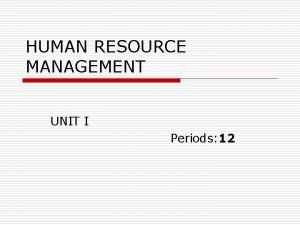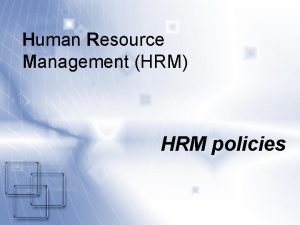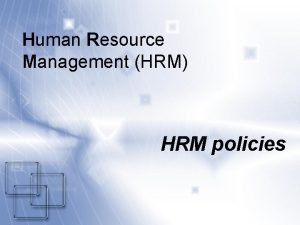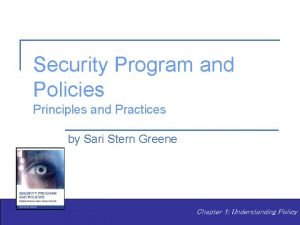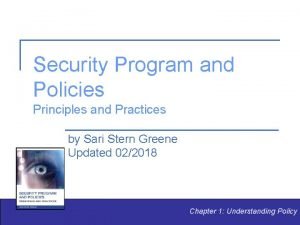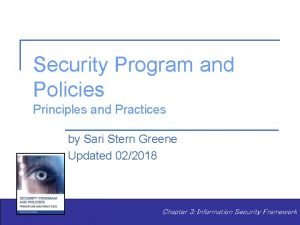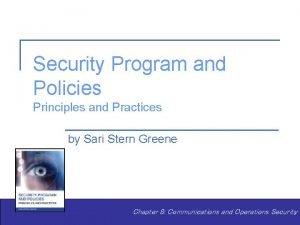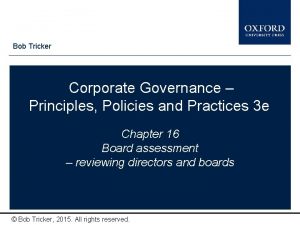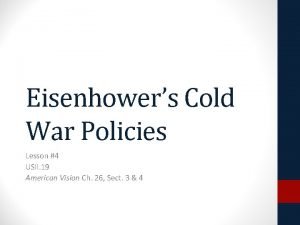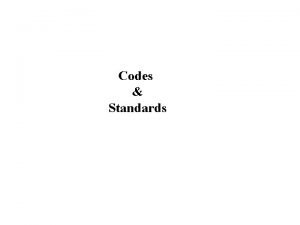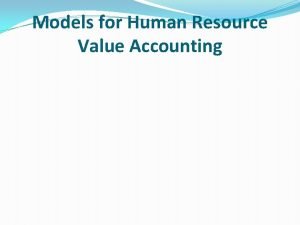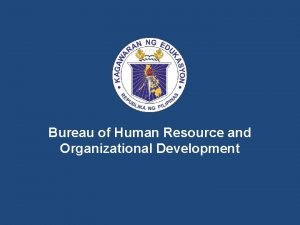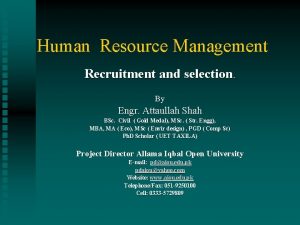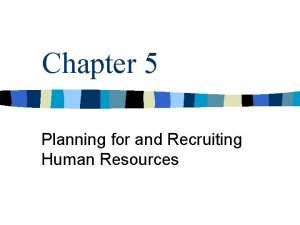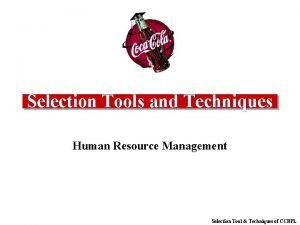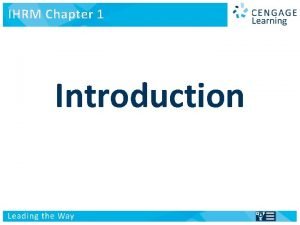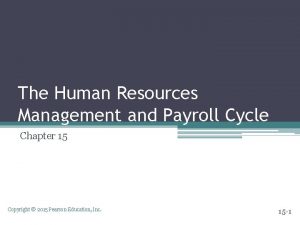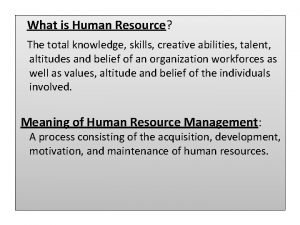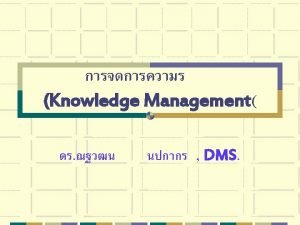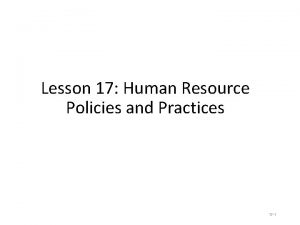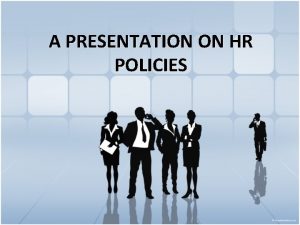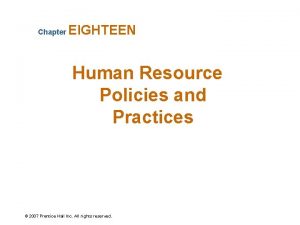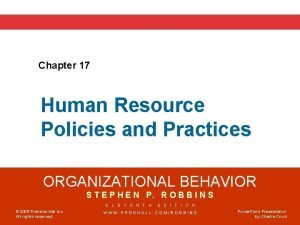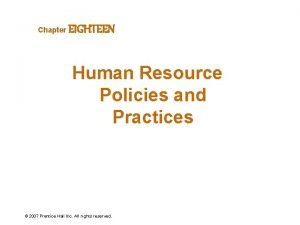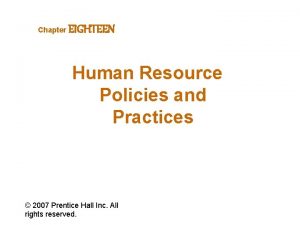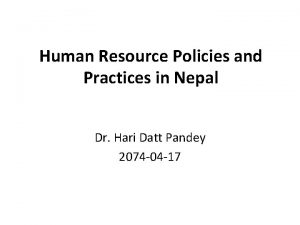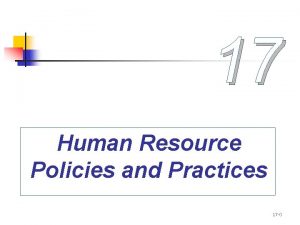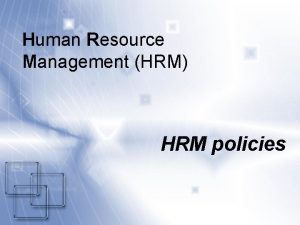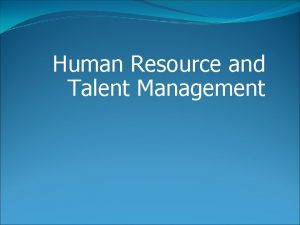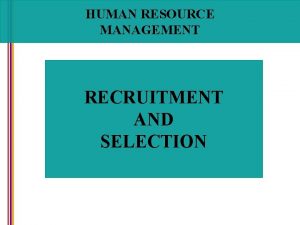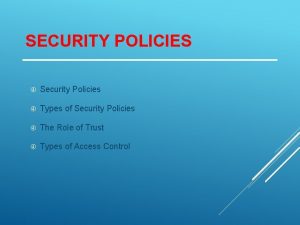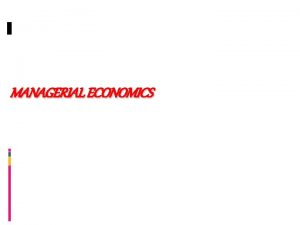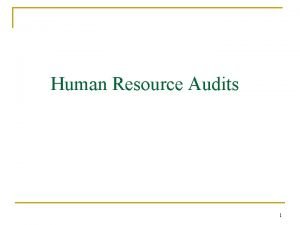Lesson 17 Human Resource Policies and Practices 17


































- Slides: 34

Lesson 17: Human Resource Policies and Practices 17 -1

Learning Objectives After studying this chapter, you should be able to: 1. 2. 3. 4. 5. 6. 7. 8. 9. Identify the most useful initial selection methods. Identify the most useful substantive selection methods. Define contingent selection. Compare the four main types of training. Contrast formal and informal training methods. Contrast on-the-job and off-the-job training. List the methods of performance evaluation. Show managers can improve performance evaluations. Describe the leadership role of HR in organizations. 17 -2

LO 1 Identify the Most Useful Substantive Selection Methods 17 -3

LO 2 Identify the Most Useful Substantive Selection Methods • Substantive Selection • Written tests • Performance simulation tests • Interviews 17 -4

LO 2 Identify the Most Useful Substantive Selection Methods • Written Tests • Typically tests of intelligence, aptitude, ability, interest, and integrity. • Intelligence tests are particularly good predictors for jobs that require cognitive complexity. • Evidence shows that these tests are good predictors, but care should be taken to use the “right” test. 17 -5

LO 2 Identify the Most Useful Substantive Selection Methods • Performance-Simulation Tests • Performance-simulation tests have higher face validity and their popularity has increased. • Work sample tests • Hands-on simulations of part or all of the job that must be performed by applicants. • Assessment centers • Evaluate managerial potential. • Situational judgment tests 17 -6

LO 2 Identify the Most Useful Substantive Selection Methods • Interviews • The most frequently used selection device. • It carries a great deal of weight. • The candidate who performs poorly in the employment interview is likely to be cut, regardless of his/her experience, test scores, or letters of recommendation, and vice versa. • Unstructured interviews are not as effective as structured ones, particularly behavioral structured interviews. 17 -7

LO 3 Define Contingent Selection • Contingent Selection • Applicants that pass the substantive selection process are ready to be hired, contingent on final checks. • A common contingent method is a drug test. • Drug testing is controversial. • Under the Americans with Disabilities Act, firms may not require employees to pass a medical exam before a job offer is made. 17 -8

LO 3 Define Contingent Selection • International Variation in Selection Processes • Selection practices differ by business culture. • Countries emphasize different techniques. • Structured interviews are popular in some countries, but not others. • Some countries like interviews and work sample tests, others prefer personal contacts and integrity tests. 17 -9

LO 4 Compare the Four Main Types of Training • There are four general skill categories for training: • Basic skills • Technical skills • Problem solving skills • Interpersonal skills • In addition, we consider: • Civility training • Ethics training 17 -10

LO 4 Compare the Four Main Types of Training • Basic Skills • Many employers believe that high school graduates lack basic skills in reading comprehension, writing, and math. • As work has become more sophisticated, the need for these basic skills has grown significantly. • It’s a worldwide problem, from the most developed countries to the least. 17 -11

LO 4 Compare the Four Main Types of Training • Technical Skills • Technical training is important for: • New technology • New structural designs • As organizations flatten their structures, expand their use of teams, and break down traditional departmental barriers, employees need mastery of a wider variety of tasks and increased knowledge of how their organization operates. 17 -12

LO 4 Compare the Four Main Types of Training • Problem-Solving Skills • Problem-solving training for managers and other employees can include: • Activities to sharpen their logic, reasoning, and problem defining skills. • Activities to improve their abilities to assess causation, develop and analyze alternatives, and select solutions. 17 -13

LO 4 Compare the Four Main Types of Training • Interpersonal Skills • Can include how to be a better listener, how to communicate ideas more clearly, and how to be a more effective team player. • Almost all employees belong to a work unit where their work performance depends on their ability to interact with co-workers and bosses. 17 -14

LO 4 Compare the Four Main Types of Training • Civility Training • As HR managers have become more aware of the effects of social behavior in the workplace, they have paid more attention to incivility, bullying, and abusive supervision in organizations. • To minimize incivility, use training targeted to building civility. 17 -15

LO 4 Compare the Four Main Types of Training • Ethics Training • Many U. S. workers receive ethics training. • Can ethics be taught? • Critics argue that ethics are based on values, and value systems are fixed at an early age. • Ethics cannot be formally “taught” but must be learned by example. • Supporters say values can be learned, and that training is helpful for recognizing ethical dilemmas and ethical issues. 17 -16

LO 5 Contrast Formal and Informal Training Methods • Training Methods • Historically, training meant “formal training”. • It is planned in advance and has a structured format. • Organizations are increasingly relying on informal training. • Unstructured, unplanned, and easily adapted to situations and individuals. 17 -17

LO 6 Contrast On-the-Job and Off-the-Job Training • Training Methods • On-the-job training includes job rotation, apprenticeships, understudy assignments, and formal mentoring programs. • Off-the-job training includes live classroom lectures, videotapes, public seminars, self-study, Internet and satellite television courses, group activities, and e-training (the fastest growing training delivery mechanism). 17 -18

LO 6 Contrast On-the-Job and Off-the-Job Training • Evaluating Effectiveness • The effectiveness of a training program can refer to the level of student satisfaction, the amount students learn, the extent to which they transfer the material from training to their jobs, or the financial return on investments in training. • An effective training program requires not just teaching the skills, but also changing the work environment to support the trainees. 17 -19

LO 7 List the Methods of Performance Evaluation • What is Performance? • Three major types of behavior to consider: 1. Task performance 2. Citizenship 3. Counter productivity • Most managers believe good performance means doing well on the first two dimensions and avoiding the third. 17 -20

LO 7 List the Methods of Performance Evaluation • Purposes of Performance Evaluation • Make general human resource decisions. • Identify training and development needs. • Pinpoint employee skills and competencies needing development. • Provide feedback to employees. • Can be the basis for reward allocations. 17 -21

LO 7 List the Methods of Performance Evaluation • What Do We Evaluate? 1. Individual task outcomes 2. Behaviors 3. Traits • Who Should Do the Evaluating? • Traditionally, the manager, but today that is changing. • Now peers, subordinates, and the employee can be involved. 17 -22

LO 7 List the Methods of Performance Evaluation 17 -23

LO 7 List the Methods of Performance Evaluation • Methods of Performance Evaluation • Written Essays • Critical Incidents • Graphic Ratings Scales • Behaviorally Anchored Rating Scales (BARS) • Forced Comparisons • Group order ranking • Individual ranking 17 -24

LO 7 List the Methods of Performance Evaluation 17 -25

LO 8 Show How Managers Can Improve Performance Evaluations • Suggestions for Improving Performance Evaluations: • Use Multiple Evaluators. • Evaluate Selectively. • Train Evaluators. • Provide Employees with Due Process • Three features of due process. • Post appraisals online. 17 -26

LO 8 Show How Managers Can Improve Performance Evaluations • Providing Performance Feedback • Managers are often uncomfortable discussing weaknesses with employees. • In fact, unless pressured by organizational policies and controls, managers are likely to ignore this responsibility. • The solution to the problem is not to ignore it but to train managers to conduct constructive feedback sessions. 17 -27

LO 8 Show How Managers Can Improve Performance Evaluations • International Variations in Performance Appraisal • Global performance evaluation across: • Individualism/collectivism • A person’s relationship to the environment • Time orientation • Focus of responsibility 17 -28

LO 9 Describe the Leadership Role of HR in Organizations • Designing and Administering Benefit Programs • HR is responsible for designing and administering an organization’s benefit program. • A benefit program should: • Be suited to the organizational culture. • Reflect the values of the organization. • Demonstrate economic feasibility. • Be sustainable in the long term. • Benefits will likely improve employees’ psychological well -being and therefore increase organizational performance. 17 -29

LO 9 Describe the Leadership Role of HR in Organizations • Drafting and Enforcing Employment Policies • Employment policies that are informed by current laws but go beyond minimum requirements will help define a positive organizational culture and set high standards for performance. • Policies differ from benefits in that they provide the guidelines for behavior, not just the working conditions. • Any policy must have enforcement to be effective. 17 -30

LO 9 Describe the Leadership Role of HR in Organizations ØManaging Work-Life Conflicts Ø Gained momentum in the 1980 s as a result of the increased entry of women in the workforce. Ø Keeping workloads reasonable, reducing work-related travel, and offering on-site quality childcare examples of practices that can help manage work-life conflicts. Ø Different people prefer different solutions. 17 -31

LO 9 Describe the Leadership Role of HR in Organizations • Mediations, Terminations, and Layoffs • Human resource departments often take center stage when unpleasant events such as disputes, substandard performance, and downsizing occur. • Employees need to be able to trust their human resource professionals to maintain appropriate confidentiality and a balanced perspective. • Managers need to be able to trust HR, too, to know the laws and represent the company’s perspective. 17 -32

Implications for Managers • An organization’s selection practices can identify competent candidates and accurately match them to the job and the organization. Consider assessment methods that are most likely to evaluate the skills directly needed for jobs you are looking to fill. • Use training programs for your employees to achieve direct improvement in the skills necessary to successfully complete the job. Employees who are motivated will use those skills for their greater productivity. 17 -33

Implications for Managers • Training programs increase an employee’s self-efficacy—that is, a person’s expectation that he or she can successfully execute the behaviors required to produce an outcome. Employees with high self-efficacy have strong expectations about their abilities to perform in new situations and are willing to exert the effort to get tasks done. • Use performance evaluations to assess an individual’s performance accurately and as a basis for allocating rewards. Make sure the performance evaluations are as fair as possible. Evaluations perceived as unfair can result in reduced effort, increases in absenteeism, or a search for another job. • Give employees the opportunity to participate in their evaluations so they understand the performance criteria and engage with the improvement process. 17 -34
 Hr policy meaning
Hr policy meaning Human resources policies
Human resources policies Hr policies and practices
Hr policies and practices Sdlc principles and practices
Sdlc principles and practices Security program and policies principles and practices
Security program and policies principles and practices Security program and policies principles and practices
Security program and policies principles and practices Security program and policies principles and practices
Security program and policies principles and practices Security program and policies principles and practices
Security program and policies principles and practices Bob tricker corporate governance
Bob tricker corporate governance Internally displaced persons ap human geography definition
Internally displaced persons ap human geography definition Baby bust definition ap human geography
Baby bust definition ap human geography Lesson 4 eisenhower's cold war policies
Lesson 4 eisenhower's cold war policies Resource loading vs resource leveling
Resource loading vs resource leveling Perbedaan resource loading dan resource leveling
Perbedaan resource loading dan resource leveling Code standards and practices lesson 3
Code standards and practices lesson 3 Lev and schwartz model example
Lev and schwartz model example Short term hr planning
Short term hr planning Human resource management question paper
Human resource management question paper Human resource management strategy and analysis
Human resource management strategy and analysis Organized retail
Organized retail Bhrod
Bhrod Operations management chapter 10
Operations management chapter 10 Human resource planning and retention
Human resource planning and retention Payroll cycle activities
Payroll cycle activities Recruitment and selection in human resource management
Recruitment and selection in human resource management Chapter 5 human resource planning and recruitment
Chapter 5 human resource planning and recruitment Selection tools in hrm
Selection tools in hrm Laurent s-step-5 for true ihrm
Laurent s-step-5 for true ihrm The human resources management and payroll cycle
The human resources management and payroll cycle Recruitment selection and induction policies and procedures
Recruitment selection and induction policies and procedures Objections against human resource accounting
Objections against human resource accounting Zero base forecasting
Zero base forecasting Human resource development framework
Human resource development framework Time management human resources
Time management human resources Project human resource management pmbok ppt
Project human resource management pmbok ppt
